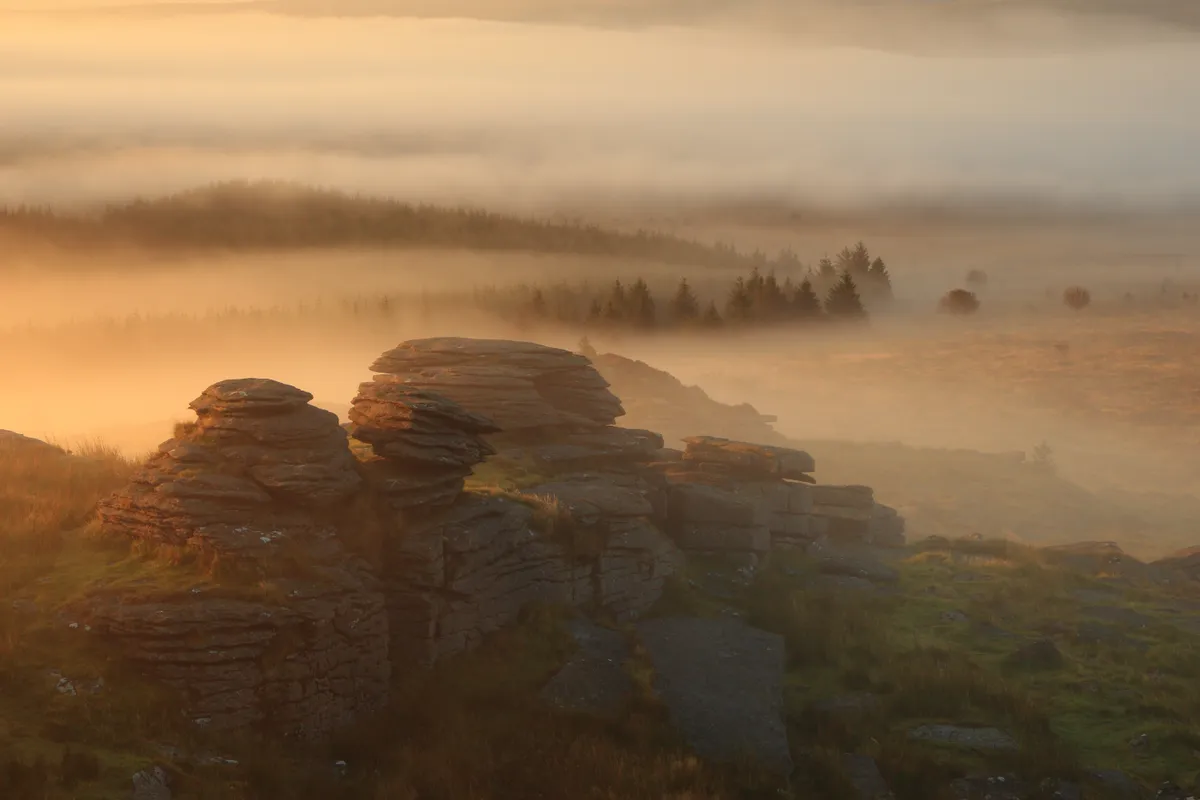Over the green squares of the fields and the low curve of a wood there rose in the distance a grey, melancholy hill, with a strange jagged summit, dim and vague in the distance, like some fantastic landscape in a dream.” Sir Arthur Conan Doyle’s description of Dartmoor has captured imaginations for more than 100 years.
Compelled by his friend Bertram Fletcher Robinson’s tales of monstrous characters, escaped convicts, demonic hounds and desperate inheritance battles, the author visited Dartmoor in 1901. It is said he walked 16-18 miles a day here, scouting for locations in which to set his fiction.
Explore Baskerville country in Dartmoor, Devon with our day out guide.

When he finally penned The Hound of the Baskervilles from the Duchy Hotel in Princetown, now the Highland Moorland Visitor Centre, he wove the real people, places and legends of Dartmoor into a tale so gripping it would become his most famous and celebrated work.
Luckily for Baskerville fans, the chilling action unfolds within a patch of Dartmoor some 6 miles across. Putting together your own tour of the locations that inspired Lafter Hall, Merripit House, the jagged peak on which Holmes hides out and the great Grimpen Mire requires but a little detective work and a sense of adventure.
The great Grimpen Mire
Fox Tor Mire, a vast shallow amphitheatre scarred with abandoned tin mines, is the only contender for Grimpen Mire. As treacherous in real life as it is in fiction, I joined a guided walk with David Brookes, who plays Sherlock Holmes in the Baskerville Dining Experience.
The glorious weather was unlike anything I’d seen before on Dartmoor and it was hard to conjure the grim mist-hugged quagmire on which Conan Doyle’s thriller unfolds. Yet even in the sun, the mire had an eerie quality – the tufts of grass strangely pale against a bold and cloudless sky.
Related articles
Patches of moss and still pools hint at the true nature of the mire, which in the book swallows ponies whole and in real life is notorious with walkers.
“A false step yonder means death to man or beast,” the fictional Stapleton had warned. David, our guide, is under no illusions: “Keep to the tufts,” he warned as I gingerly stepped in his footprints, “and if you get worried at any time just shout and we’ll stop.” I was more than a little unnerved. Our steps alternated from springy peat to deep spongy moss that began to pull us under, as Watson said: “as if some malignant hand was tugging us down into those obscene depths.”
Legendary Dartmoor
Once safely across, we came to a lichen-covered granite cross. David tells me that the cross commemorates Childe the Hunter, an 11th century Saxon earl who became stranded by a blizzard. In an attempt to stay alive, he disembowelled his pony and crawled inside, scrawling a message in blood to say that whoever buried his body in hallowed ground could claim his estate. He then froze to death on this spot.
As we walk, David recounts more Dartmoor legends, including a tale about Squire Richard Cabell, a monstrously evil man who lived in Brook Manor, north of Buckfastleigh, in the 17th century. The squire would gallop across Dartmoor accompanied by hounds the size of ponies. When he died, the villagers buried him in Holy Trinity Church in Buckfastleigh, but that night a phantom, fire-breathing pack of dogs came baying across the moor to howl at his tomb.

To silence his restless spirit, the villagers built a thick granite mausoleum around Cabell’s grave where, for now, he waits.
Bellever Tor
Noting the likely location of Lafter Hall (Laughter Hole House), David believes that the “jagged pinnacle of granite” on which Watson spots the mysterious moonlit silhouette of Holmes can only be Bellever Tor.
As the sun lowers in the sky, we scramble to the summit and survey Baskerville Country. To the south-west lies Princetown, where the author wrote under the brooding shadow of the prison. Further still lies the vast mire and all around the “desolate, lifeless moor” that captivated Conan Doyle stretches to the horizon.
“The longer one stays here,” Watson had written to Holmes, “the more does the spirit of the moor sink into one’s soul, its vastness, and also its grim charm.” Sitting on the very spot Conan Doyle forged his tale more than a century ago, I can’t help but agree.
Useful Information
HOW TO GET THERE
The walk on Fox Tor Mire starts at Whiteworks Tin Mine, 2½ miles south-east of Princetown.
MORE INFO
The Baskerville Experience
Laughter Hole House, Postbridge, Dartmoor PL20 6TT
baskerville-experience.co.uk
An evening full of high drama and Victorian cuisine, starting with a guided tour across Grimpen Mire, followed by dinner with Sherlock Holmes.
STAY
Lower Willsworthy Cottage
www.holidaycottages.co.uk
Guests at this refurbished three-bedroom cottage,
7 miles north of Tavistock, have the run of the owner’s 40-acre farm within the National Park. A large, well-equipped kitchen, lounge with woodburner and beautifully decorated bedrooms ensure a relaxing stay.